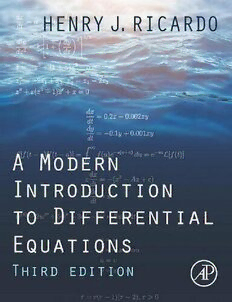Table Of ContentA Modern Introduction
to Differential
Equations
A Modern Introduction
to Differential
Equations
Third Edition
Henry J. Ricardo
Medgar Evers College
The City University of New York
Brooklyn, NY, United States
AcademicPressisanimprintofElsevier
125LondonWall,LondonEC2Y5AS,UnitedKingdom
525BStreet,Suite1650,SanDiego,CA92101,UnitedStates
50HampshireStreet,5thFloor,Cambridge,MA02139,UnitedStates
TheBoulevard,LangfordLane,Kidlington,OxfordOX51GB,UnitedKingdom
Copyright©2021ElsevierInc.Allrightsreserved.
Nopartofthispublicationmaybereproducedortransmittedinanyformorbyanymeans,electronic
ormechanical,includingphotocopying,recording,oranyinformationstorageandretrievalsystem,
withoutpermissioninwritingfromthepublisher.Detailsonhowtoseekpermission,further
informationaboutthePublisher’spermissionspoliciesandourarrangementswithorganizationssuch
astheCopyrightClearanceCenterandtheCopyrightLicensingAgency,canbefoundatourwebsite:
www.elsevier.com/permissions.
Thisbookandtheindividualcontributionscontainedinitareprotectedundercopyrightbythe
Publisher(otherthanasmaybenotedherein).
Notices
Knowledgeandbestpracticeinthisfieldareconstantlychanging.Asnewresearchandexperience
broadenourunderstanding,changesinresearchmethods,professionalpractices,ormedicaltreatment
maybecomenecessary.
Practitionersandresearchersmustalwaysrelyontheirownexperienceandknowledgeinevaluating
andusinganyinformation,methods,compounds,orexperimentsdescribedherein.Inusingsuch
informationormethodstheyshouldbemindfuloftheirownsafetyandthesafetyofothers,including
partiesforwhomtheyhaveaprofessionalresponsibility.
Tothefullestextentofthelaw,neitherthePublishernortheauthors,contributors,oreditors,assume
anyliabilityforanyinjuryand/ordamagetopersonsorpropertyasamatterofproductsliability,
negligenceorotherwise,orfromanyuseoroperationofanymethods,products,instructions,orideas
containedinthematerialherein.
LibraryofCongressCataloging-in-PublicationData
AcatalogrecordforthisbookisavailablefromtheLibraryofCongress
BritishLibraryCataloguing-in-PublicationData
AcataloguerecordforthisbookisavailablefromtheBritishLibrary
ISBN:978-0-12-823417-4
ForinformationonallAcademicPresspublications
visitourwebsiteathttps://www.elsevier.com/books-and-journals
Publisher:KateyBirtcher
EditorialProjectManager:AndraeAkeh
ProductionProjectManager:BeulaChristopher
Designer:BrianSalisbury
TypesetbyVTeX
ForCatherine,thesolestableequilibriumpointinmylife,and forall
thesecondderivatives:
Tomásand NicholasRicardo
ChristopherCorcoran
Joshua andElizabethGritmon
Contents
Preface ...................................................... xi
Acknowledgments ............................................. xv
CHAPTER 1 Introduction to differential equations ............. 1
Introduction ...................................... 1
1.1 Basicterminology ................................. 2
1.2 Solutionsofdifferentialequations ..................... 8
1.3 Initial-valueproblemsandboundary-valueproblems ....... 14
Summary ........................................ 25
CHAPTER 2 First-order differential equations ................. 27
Introduction ...................................... 27
2.1 Separableequations ................................ 27
2.2 Linearequations .................................. 39
2.3 Compartmentproblems ............................. 50
2.4 Slopefields ...................................... 57
2.5 Phaselinesandphaseportraits ........................ 72
2.6 Equilibriumpoints:sinks,sources,andnodes ............. 78
2.7 Bifurcations ...................................... 87
*2.8 Existenceanduniquenessofsolutions1 ................. 98
Summary ........................................ 108
CHAPTER 3 The numerical approximation of solutions ........ 111
Introduction ...................................... 111
3.1 Euler’smethod ................................... 111
3.2 TheimprovedEulermethod .......................... 131
3.3 Moresophisticatednumericalmethods:Runge–Kuttaand
others .......................................... 135
Summary ........................................ 140
CHAPTER 4 Second- and higher-order equations ............. 143
Introduction ...................................... 143
4.1 Homogeneoussecond-orderlinearequationswithconstant
coefficients ...................................... 143
4.2 Nonhomogeneoussecond-orderlinearequationswithconstant
coefficients ...................................... 154
4.3 Themethodofundeterminedcoefficients ................ 156
4.4 Variationofparameters ............................. 165
4.5 Higher-orderlinearequationswithconstantcoefficients ..... 172
*4.6 Existenceanduniqueness1 ........................... 177
Summary ........................................ 181
vii
viii Contents
CHAPTER 5 The Laplace transform .......................... 185
Introduction ...................................... 185
5.1 TheLaplacetransformofsomeimportantfunctions ........ 186
5.2 Theinversetransformandtheconvolution ............... 194
5.3 Transformsofdiscontinuousfunctions .................. 205
5.4 Transformsofimpulsefunctions—theDiracdeltafunction .. 213
5.5 Transformsofsystemsoflineardifferentialequations ...... 217
*5.6 Laplacetransformsoflineardifferentialequationswith
variablecoefficients1 ............................... 223
Summary ........................................ 227
CHAPTER 6 Systems of linear differential equations .......... 231
Introduction ...................................... 231
6.1 Higher-orderequationsandtheirequivalentsystems........ 231
*6.2 Existenceanduniqueness1 ........................... 239
6.3 Numericalsolutionsofsystems ....................... 244
6.4 Thegeometryofautonomoussystems .................. 253
6.5 Systemsandmatrices............................... 265
6.6 Two-dimensionalsystemsoffirst-orderlinearequations ..... 271
6.7 Thestabilityofhomogeneouslinearsystems:unequalreal
eigenvalues ...................................... 286
6.8 Thestabilityofhomogeneouslinearsystems:equalreal
eigenvalues ...................................... 298
6.9 Thestabilityofhomogeneouslinearsystems:complex
eigenvalues ...................................... 305
6.10 Nonhomogeneoussystems ........................... 314
*6.11 Spring-massproblems1 ............................. 325
6.12 Generalizations:then×ncase(n≥3) ................. 340
Summary ........................................ 357
CHAPTER 7 Systems of nonlinear differential equations ....... 361
Introduction ...................................... 361
7.1 Equilibriaofnonlinearsystems ....................... 361
7.2 Linearapproximationatequilibriumpoints .............. 366
7.3 TheHartman–Grobmantheorem ...................... 375
7.4 Twoimportantnonlinearsystems ...................... 384
7.5 Bifurcations ...................................... 397
*7.6 LimitcyclesandtheHopfbifurcation1 .................. 402
Summary ........................................ 418
APPENDIX A Some calculus concepts and results . . . . . . . . . 421
A.1 Locallinearity:thetangentlineapproximation ............ 421
A.2 Thechainrule .................................... 422
A.3 TheTaylorpolynomial/Taylorseries ................... 422
A.4 Thefundamentaltheoremofcalculus ................... 425
A.5 Partialfractions ................................... 426
Contents ix
A.6 Improperintegrals ................................. 427
A.7 Functionsofseveralvariables/partialderivatives .......... 429
A.8 Thetangentplane:theTaylorexpansionofF(x,y) ........ 431
APPENDIX B Vectors and matrices . . . . . . . . . . . . . . . . . . . . 433
B.1 Vectorsandvectoralgebra;polarcoordinates ............. 433
B.2 Matricesandbasicmatrixalgebra ..................... 436
B.3 Lineartransformationsandmatrixmultiplication .......... 437
B.4 Eigenvaluesandeigenvectors ......................... 442
APPENDIX C Complex numbers . . . . . . . . . . . . . . . . . . . . . . . 445
C.1 Complexnumbers:thealgebraicview .................. 445
C.2 Complexnumbers:thegeometricview.................. 446
C.3 Thequadraticformula .............................. 448
C.4 Euler’sformula ................................... 448
APPENDIX D Series solutions of differential equations . . . . . . 449
D.1 Powerseriessolutionsoffirst-orderequations ............ 449
D.2 Seriessolutionsofsecond-orderlinearequations:ordinary
points .......................................... 451
D.3 Regularsingularpoints:themethodofFrobenius .......... 454
D.4 Thepointatinfinity ................................ 458
D.5 Someadditionalspecialdifferentialequations ............ 460
Answersandhintstoodd-numberedexercises ......................... 461
Index ....................................................... 525
1 ∗Denotesanoptionalsection.
Preface
Philosophy
The evolution of the differential equations course I described in the prefaces to the
first two editions of this book has progressed nicely. In particular, the quantitative,
graphical,andqualitativeaspectsofthesubjecthavebeenreceivingincreasedatten-
tion,dueinlargeparttotheavailabilityoftechnologyintheclassroomandathome.
Asdidthepreviouseditions,thisneweditionpresentsasolidyethighlyaccessible
introductiontodifferentialequations,developingmanyconceptsfromtheperspective
ofdynamicalsystemsandemployingtechnologytotreattopicsgraphically,numer-
ically, and analytically. In particular, the book acknowledges that most differential
equationscannotbesolvedinclosedformandmakesextensiveuseofqualitativeand
numericalmethodstoanalyzesolutions.
Thetextincludesdiscussionsofmanysignificantmathematicalmodels,although
thereisnosystematicattempttoteachtheartofmodeling.Similarly,thetextintro-
ducesonlytheminimumamountoflinearalgebrasufficientforananalysisofsystems
ofequations.
Thisbookisintendedtobethetextforaone-semesterordinarydifferentialequa-
tionscoursethatistypicallyofferedatthesophomoreorjuniorlevel,butwithsome
differences. The prerequisite for the course is two semesters of calculus. No prior
knowledgeofmultivariablecalculusandlinearalgebraisneededbecausebasiccon-
cepts from these subjects are developed within the text itself. This book is aimed
primarily at students majoring in mathematics, the natural sciences, and engineer-
ing. However, students in economics, business, and the social sciences who have
the necessary background should also benefit from the material presented in this
book.
Use of technology
This text assumes that the student has access to a computer algebra system (CAS)
or perhaps some specialized software that will enable him or her to construct the
required graphs (solution curves, slope fields, phase portraits, etc.) and numerical
approximations.Forexample,aspreadsheetprogramcanbeusedeffectivelytoim-
plement Euler’s method of approximating solutions. Although I have used Maple®
in my own teaching, no specific software or hardware platform is assumed for this
book.Toalargeextent,evenagraphingcalculatorwillsuffice.
xi

